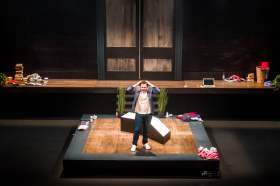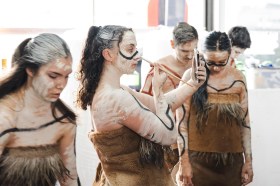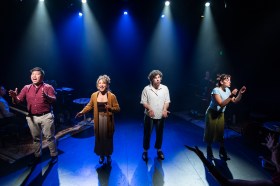Set in Oxford in late Victorian England, The Dictionary of Lost Words’ fictional characters, Esme and her father Harry Nicoll, are interwoven around real-life people of the time. Harry is a lexicographer helping to create the first Oxford English Dictionary while Esme assists her ‘Da’ in the Scriptorium (Scrippy), a converted shed in the garden of Sir James Murray’s house, the real-life compiler of the Dictionary. Discovering words on slips of paper, some of which have been discarded or forgotten, many having female references and considered ‘less valuable’, Esme starts a collection to create her own Dictionary of Lost Words.
Jonathon Oxlade’s set is visually delightful, its myriad pigeonholes filled with saved words set against a curved back wall, encasing a hidden staircase and two doors. A huge screen above the structure denotes the passage of time and shows assorted imagery, operated by the actors from an onstage projector. Carefully crafted period costumes designed by Ailsa Paterson enhance the language and manners of the period perfectly. Esme’s costumes as a child are splendidly realised.
Suitable atmospheric and romantic lighting from Trent Suidgeest additionally uses nuanced coloured lights within the pigeonholes themselves. Max Lyandvert’s electronic soundscape is melancholic and dramatic, but essentially melodic to link the many scenes.
Within the confines of the play’s structure and style, Jessica Arthur directs a tightly delivered script with smooth transitions between the multiple scenes. The play is quite serious and dry, with limited humour; more levity and wit in the production would be welcome.
The cast are excellent and work hard. Shannen Alyce Quan gives an astonishingly powerful performance as Esme, in a role that takes her from child to adult over 30 years. Starting as an inquisitive four-year-old in 1886, complete with ringlets and a Victorian smock, she mouths and collects words under the sorting table in the Scrippy. She grows into adulthood, demonstrating both independence and the influences of the Suffragette movement, while her commitment to the Dictionary never wavers.
Johnny Nasser’s finely nuanced performance as Harry balances that of the workaholic Murray, played with panache and a lightness of touch by Brian Meegan. Esme’s love interests, James Smith’s Bill Taylor and Arkia Ashraf’s Gareth, offer intelligent cameos.
Kathryn Adams is impressive and believable as the Murray’s maid and Esme’s confidant, Lizzie Lister. Ksenja Logos is the kindly, smart godmother, Edith (Ditte). Doubling in the comic role of the Cockney market stall holder, Mable, and later as Esme’s daughter, Alice, she delivers her separate roles with aplomb. Angela Nica Sullen is dextrous in playing three distinctive characters as lexicographer Arthur Maling, actress turned sharp-witted suffragette Tilda Taylor, and the gentle Sarah, who adopts Esme’s baby.
Perhaps the social changes of the period, with nods to the Suffragette movement in the book, could have resulted in a more meaningful and thought-provoking dramatic interpretation in the play. Verity Laughton’s script relies heavily on regurgitating text-loaded exposition or dialogue from the 400-page novel. The drama required to make the play and its characters sparkle and excite often appears lacklustre and dreary, however hard the cast tries.
There are moments of lightness and fun, such as Mable and her ‘street’ words, and the repetitive daily greetings of Murray’s team of workers. There is the drama of Esme giving birth with her facial images on screen, though scant attention is paid to her feelings as the baby is removed. Equally she quickly recovers after learning of Gareth’s death on the battlefield, with potential audience reaction lost.
Read: Theatre review: Shadow of Doubt, The Blue Room Theatre
At nearly three hours, the play suffers from being overloaded with too much information and inconsequential plot developments. One is left wondering what it is trying to impart; entertaining enough, and visually lovely to watch, it could offer so much more.
The Dictionary of Lost Words
Playhouse, QPAC
Presented by State Theatre Company of South Australia, Sydney Theatre Company and QPAC
Adapted by Verity Laughton from the novel by Pip Williams
Playwright: Verity Laughton
Author: Pip Williams
Director: Jessica Arthur
Set Designer: Jonathon Oxlade
Costume Designer: Ailsa Paterson
Lighting Designer: Trent Suidgeest
Composer/Sound Designer: Max Lyandvert
Assistant Director: Shannon Rush
Intimacy/Fight Choreographer: Ruth Fallon
Cast: Shannen Alyce Quan, Johnny Nasser, Kathryn Adams, Brian Meegan, Ksenja Logos, Arkia Ashraf, Angela Nica Sullen, James Smith
The Dictionary of Lost Words will be performed until 10 May 2025 at the QPAC, Brisbane before touring to IPAC Wollongong from 29 May to 7 June 2025.





